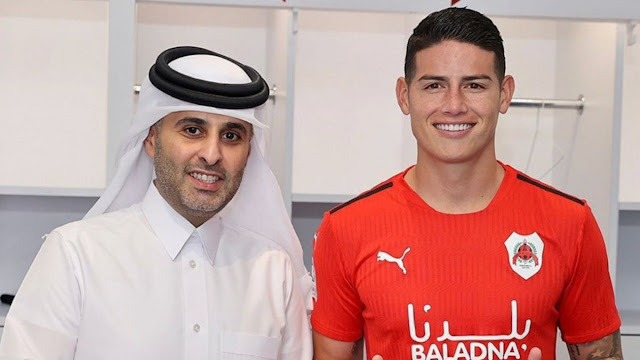Letter from Colombia
 |
| James to Al-Rayyan |
I visit Colombia every year and am always happy to be in a land which loves football. I fell in love with Colombian football long before I came to love the nation in fact.
It was that crazy match at the 1990 World Cup where the red-shirted Colombians outplayed eventual winners West Germany for periods of the match with mesmeric passing but played for a draw, their mercurial skipper Carlos Valderrama even feigning injury, requesting a stretcher which carried him around the pitch before he jumped off it.
When Germany scored with an 88th minute Pierre Littbarski strike it looked like Colombia's gamble had failed. But then a slick passing move set up by Valderrama saw Freddy Rincon nutmeg Bodo Illgner to spark extraordinary celebrations.
With the 'birdman' flapping from the stands, Colombia's circus continued to the second round where more monkey business from goalkeeper Rene Higuita, he of the famous scorpion kick, saw Roger Milla and Cameroon eliminate them.
Colombia's craziness had grabbed me.
The insanity around Colombian football took a dark turn four years later with Andres Escobar's tragic murder following his own goal at USA '94 but the overall impression of a wildly talented football culture remained, through the mercurial Faustino Asprilla through to James Rodriguez's wonder goal at Brazil 2014.
To see this society mobilise in a sea of yellow to support 'La Seleccion' (the national team) in its competitive fixtures really is something to behold. Bogota's notorious traffic congestion (a city the size of London without a metro) magically evaporates every time Los Cafeteros (the coffee men) take the field.
England does not compare. You do not see Three Lions shirts everywhere on the day of a World Cup qualifier.
Colombia never play in Bogota alas, possibly because of the high altitude, which caused some friction with Brazil a few years ago, but also because the Metropolitano stadium in Caribbean Baranquilla holds 20,000 more fans.
While the Adidas store in my local shopping centre Plaza Las Americas sells the real McCoy at 'La camiseta' (the team jersey) at its RRP of £48, knock-offs can be had for around a fiver from several city centre street traders, brazenly flogging very good copies or ones which say 'Abibas' or suchlike.
As a nation, Colombia has plenty of problems - an ongoing triangular conflict between the army, leftist rebels and right-wing paramilitaries, narcotraffic, political corruption, inadequate transport infrastructure and pollution for starters.
Against this backdrop of perennial frustration, the people look to the national team and World Cups in particular as a time to forget their troubles and celebrate communally. Dance and music, two cultural totems of this nation, arguably serve the same purpose.
Equally, there are those who criticise the obsession with 'La Seleccion' as a bread and circuses political manipulation of a population who deserve much better in their daily lives.
Football like any national obsession leaves itself open to exploitation by vested interests. Yet despite all that the show must go on and true lovers of football retain a faith in the Beautiful Game.
Historically the domestic league here is not at the level of Argentina or Brazil's - Colombian clubs have only won the Copa Libertadores three times in its history compared to 25 times for Argentine teams, 18 for Brazilian clubs and eight for Uruguayan ones. However in 2018 the statistics institute the IFFHS ranked the Colombian first division ahead of Argentina's but behind Brazil's in South America.
Bogota, like many capital cities, does not have the football fever of the country's second city Medellin. Capital clubs Millionarios and Santa Fe only attracted an average of 13,924 and 8,449 fans respectively last season and the city's third team La Equidad 1,281.
While I am always keen to see new teams play the locals, even committed fans, warn you to watch out for the crowd trouble. Sure enough, this weekend a Millionarios fan launched a combat knife at the field...
In a football-mad city of seven million people, it is clear therefore that fans get their football fix elsewhere. Most people here have a cable TV package which means access via ESPN and Fox Sports to international leagues as well as the domestic one.
This weekend on TV I could watch live games from all the Big Four European leagues, MLS and Argentina in addition to the Colombian Primera A - spoilt for choice. I could also watch the MLB, the Rugby World Cup and even Argentinian polo.
Inevitably, Spain's big two are most popular here but the EPL also has a following of sorts, helped by the presence of national team regulars Jefferson Lerma, Jerry Mina and Davinson Sanchez. In fact the media gleefully reports any Colombians abroad who are doing well, including Rangers' striker Alfredo Morelos.
Only four of their most recent squad play in Colombia, meaning there is a global perspective on football here. How much better would it be if that were the case for England?
James Rodriguez's unlikely return to Real Madrid under Zinedine Zidane has increased the already big following Los Blancos have in his native country but one suspects the 2014 World Cup Golden Boot winner may have peaked. Radamel 'El Tigre' Falcao is still going strong aged 33 with Galatasaray in his seventh country as a player and remains in the national team set-up too.
In charge of 'La Seleccion' is another multi-country veteran and former Manchester United assistant coach Carlos Queiroz, now working in his ninth nation. World Cup 2022 qualifers are set to start in late March of next year and qualification will be the minimum expectation after a last eight finish in 2014 and a penalty exit to England last year.
Next summer Colombia jointly host the Copa America with Argentina with Australia and Qatar the invited nations to make up the numbers.
Expect more seas of yellow and national fervour. Colombia and football remain inseparable.
(c) Sean O'Conor & Soccerphile